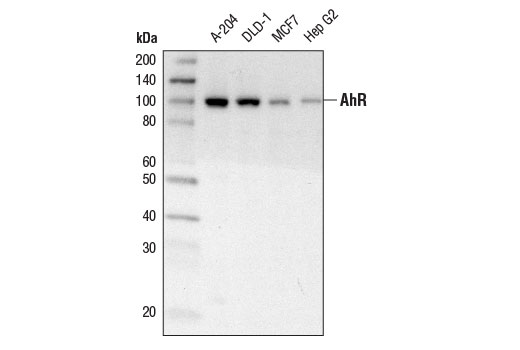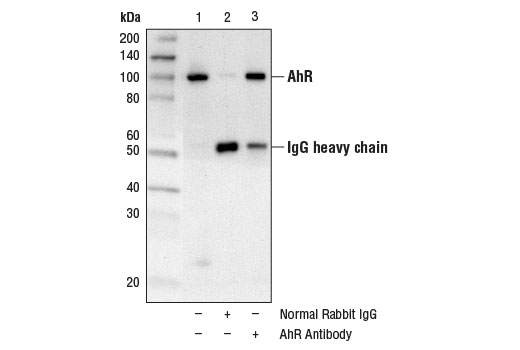WB, IP
H
Endogenous
100
Rabbit
#P35869
196
Product Information
Product Usage Information
| Application | Dilution |
|---|---|
| Western Blotting | 1:1000 |
| Immunoprecipitation | 1:100 |
Storage
Specificity / Sensitivity
Species Reactivity:
Human
Source / Purification
Polyclonal antibodies are produced by immunizing animals with a synthetic peptide corresponding to residues near the carboxy terminus of human AhR protein. Antibodies are purified by protein A and peptide affinity chromatography.
Background
The aryl hydrocarbon receptor (AhR) is a ligand activated transcription factor involved in xenobiotic metabolism, cell cycle regulation, and development in response to both endogenous and environmental signals (1,2). AhR was initially identified as a receptor for dioxins, which are environmental pollutants generated by waste incineration and other industrial processes (3,4). AhR ligands include polycyclic aromatic hydrocarbons, including the carcinogen benzo(a)pyrene and other components of cigarette smoke (3,4). Naturally occurring AhR ligands include flavonoids, which are aromatic plant secondary compounds commonly found in vegetables and fruits (3). Cytoplasmic aryl hydrocarbon receptors are found in protein complexes with heat shock proteins. Upon ligand binding, AhR dissociates from heat shock proteins and translocate to the nucleus where it dimerizes with AhR nuclear translocator (ARNT, HIF-1β). The AhR/ARNT heterodimer binds to nuclear xenobiotic response elements to control the expression of genes associated with xenobiotic metabolism, including several cytochrome P450 genes (5,6). AhR is ubiquitously expressed and is thought to play a role in regulation of cell proliferation and differentiation, cytokine expression, and xenobiotic metabolism (2). Research studies link AhR activity with the control of regulatory T-cell and T-helper 17 cell differentiation, regulation of the inflammatory response, and the onset of lung cancer (1,2,7,8).
- Quintana, F.J. (2013) Immunology 138, 183-9.
- Tsay, J.J. et al. (2013) Anticancer Res 33, 1247-56.
- Denison, M.S. and Nagy, S.R. (2003) Annu Rev Pharmacol Toxicol 43, 309-34.
- Poland, A. and Knutson, J.C. (1982) Annu Rev Pharmacol Toxicol 22, 517-54.
- Denison, M.S. et al. (2002) Chem Biol Interact 141, 3-24.
- Beischlag, T.V. et al. (2008) Crit Rev Eukaryot Gene Expr 18, 207-50.
- Quintana, F.J. et al. (2008) Nature 453, 65-71.
- Hayden, M.S. and Ghosh, S. (2004) Genes Dev 18, 2195-224.
Species Reactivity
Species reactivity is determined by testing in at least one approved application (e.g., western blot).
Western Blot Buffer
IMPORTANT: For western blots, incubate membrane with diluted primary antibody in 5% w/v BSA, 1X TBS, 0.1% Tween® 20 at 4°C with gentle shaking, overnight.
Applications Key
WB: Western Blotting IP: Immunoprecipitation
Cross-Reactivity Key
H: human M: mouse R: rat Hm: hamster Mk: monkey Vir: virus Mi: mink C: chicken Dm: D. melanogaster X: Xenopus Z: zebrafish B: bovine Dg: dog Pg: pig Sc: S. cerevisiae Ce: C. elegans Hr: horse GP: Guinea Pig Rab: rabbit All: all species expected
Trademarks and Patents
Limited Uses
Except as otherwise expressly agreed in a writing signed by a legally authorized representative of CST, the following terms apply to Products provided by CST, its affiliates or its distributors. Any Customer's terms and conditions that are in addition to, or different from, those contained herein, unless separately accepted in writing by a legally authorized representative of CST, are rejected and are of no force or effect.
Products are labeled with For Research Use Only or a similar labeling statement and have not been approved, cleared, or licensed by the FDA or other regulatory foreign or domestic entity, for any purpose. Customer shall not use any Product for any diagnostic or therapeutic purpose, or otherwise in any manner that conflicts with its labeling statement. Products sold or licensed by CST are provided for Customer as the end-user and solely for research and development uses. Any use of Product for diagnostic, prophylactic or therapeutic purposes, or any purchase of Product for resale (alone or as a component) or other commercial purpose, requires a separate license from CST. Customer shall (a) not sell, license, loan, donate or otherwise transfer or make available any Product to any third party, whether alone or in combination with other materials, or use the Products to manufacture any commercial products, (b) not copy, modify, reverse engineer, decompile, disassemble or otherwise attempt to discover the underlying structure or technology of the Products, or use the Products for the purpose of developing any products or services that would compete with CST products or services, (c) not alter or remove from the Products any trademarks, trade names, logos, patent or copyright notices or markings, (d) use the Products solely in accordance with CST Product Terms of Sale and any applicable documentation, and (e) comply with any license, terms of service or similar agreement with respect to any third party products or services used by Customer in connection with the Products.

